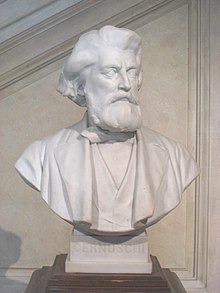Enrico Cernuschi
Enrico Cernuschi , French / English Henri Cernuschi , [ tʃɛrˈnuski ] (born February 19, 1821 in Milan , † May 12, 1896 in Menton , Côte d'Azur ) was an Italian- French political economist , politician, banker and art collector.
Cernuschi was born to wealthy parents and should become a lawyer if they wanted. During his studies he came into contact with the revolutionary movement in Italy . As an avid Garibaldian, he was involved in uprisings in Milan (1848) and Rome (1849). In Rome he had a seat in the National Assembly. After the failure of the revolutionary government, he was arrested in 1850 and after a year in captivity in Civitavecchia and Castel Sant'Angelo, he was able to flee to France . Here he was naturalized and made a great fortune through trading and banking. He worked first at Arago and later at Crédit Mobilier . He was the founder (together with Adrien Delahate and Edmond Joubert ) of the Banque de Paris (which merged in 1872 with the Banque de Crédit et de dépôt des Pays-Bas to form the Banque de Paris et des Pays-Bas , later Paribas ).
He played a role in France in the resistance against the socialist movement . He had to flee again in 1870 after he had used a large sum to equip a committee that was supposed to fight the Napoleonic plebiscites . With the establishment of the Third Republic in September 1870, he was able to return. But he soon left Paris for a longer trip to the Far East .
Together with the art critic and journalist Théodore Duret , he toured Egypt , China , Japan , Java , Ceylon and India . From this trip Cernuschi brought numerous works of art to France in 1873, which he later donated to the city of Paris . This collection of Asian art is exhibited today at the Musée Cernuschi .
In 1876 he toured Great Britain and in 1877 the United States , giving lectures on economic issues. Cernuschi is best known for his publications on financial issues, particularly the bimetallic issue , in which he was a proponent of the silver base. The word itself is said to have been used for the first time, at least in the English form, in one of his publications, Silver Vindicated (1876).
Works
- Réponse à une accusation portée par Mr. de Cavour (1861)
- Mécanique de l'échange (1855)
- Contre le billet de banque, déposition et notes (1866)
- Illusions des sociétés coopératives (1866)
- Discours (1871)
Later he dealt exclusively with the currency question. He agitated for a general dual currency to be introduced by contract ( bimetallism ). He wrote about it:
- Or et argent (1874)
- La Question Monétaire en Allemagne (1875)
- Silver vindicated (1876)
- Mr. Michel Chevalier et le bimétallisme (1876)
- La Diplomatie Monétaire en 1878 (1878)
- Le Bimétallisme en Angleterre (1879)
- Le Bimetalisme à quinze et demi
- Le Grand Procès de l'Union latine (1884)
- and other pamphlets .
literature
- Franco Della Peruta: Cernuschi, Enrico. In: Alberto M. Ghisalberti (Ed.): Dizionario Biografico degli Italiani (DBI). Volume 23: Cavallucci-Cerretesi. Istituto della Enciclopedia Italiana, Rome 1979.
Web links
| personal data | |
|---|---|
| SURNAME | Cernuschi, Enrico |
| ALTERNATIVE NAMES | Cernuschi, Henri |
| BRIEF DESCRIPTION | Italian economist, politician, banker and art collector |
| DATE OF BIRTH | February 19, 1821 |
| PLACE OF BIRTH | Milan |
| DATE OF DEATH | May 12, 1896 |
| Place of death | Menton |

